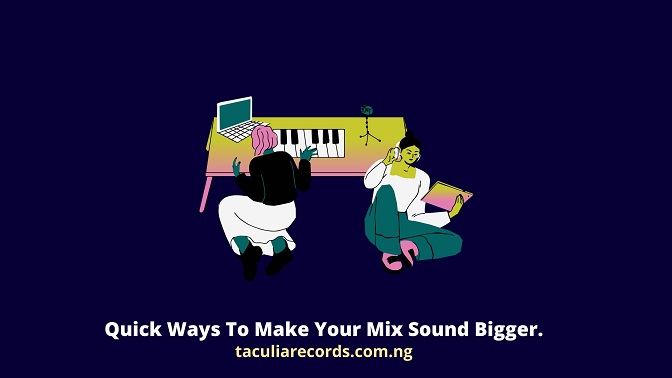You’ve finally been able to balance all our tracks and have everything sitting nicely as well as sounding punchy and well-defined, now your next line of action, and probably the final aim is to add a little pop and life to the mix.
And for that reason, I wrote this article that will show you 5 quick ways to make your mix sound bigger.
5 quick ways to make your mix sound bigger.
Below are the 5 quick ways you can make your mix sound bigger:
- Use exciters and enhancers.
- Add saturation.
- Use parallel distortion.
- Add reverb.
- Use frequency-based modulation.
1. Use exciters and enhancers.
A quick and easy way to add a little spark to your sound is to use harmonic exciters and enhancers. But just be careful while doing so as a little will usually go a long way.
From my observation, exciters tend o give n immediate gratification by focusing on colorful harmonics in the sound, but this is often at the expense of the rest of the frequency domain.
Don’t use these effects as a substitute for EQ. Once you are making distinct frequency boosts with any of these tools, it is going to be too much.
2. Add saturation.
Saturation and overdrive go hand in hand in that they will give you just enough to give life to whatever it is you are saturating.
Saturation is not limited to emulation plugins, and for that reason, any piece of hardware can be used as a saturator. An experiment that’s going to be worth it is to run a signal through a preamp and crank the gain while listening to how the texture changes.
Really nice preamps overdriven a bit can bring out certain textures and frequencies in a very cool and unique way.
3. Use parallel distortion.
When using parallel distortion, make sure you clone your source and run the clone through distortion from there, equalizing the distorted clone in order to highlight the frequency you wish to enhance.
If you want your mids to be thicker, Hi-Pass and Low-Pass the clone.
If you need your upper mid-range to be more excited, then throw a Hi-Pass at around 1.5KHZ. Then take the cloned signal and start blending it against the original.
About 15 dB down from the original, you will start to hear a noticeable change in the texture and liveliness of the original.
A little punch will go a very long way here.
4. Add reverb.
Early reflection heavy, short-tail reverbs will always have a unique power over a dry source.
What we hear in the Reverb is what we will quickly prescribe onto the dry signal.
In other words, if you want to make your mix brighter, but regular EQ methods seem not to be working out, you can use a short, bright Reverb to make the high end of your dry source come alive.
Plate emulations are preferable in this kind of method because rooms and halls tend to be too open sounding.
5. Use frequency-based modulation.
Using frequency-based modulation such as the enigma plugins from waves, lor flangers, and phasers can be really interesting in several ways.
These effects tend to be a bit more dramatic than the other one.
But sometimes a sound needs to come back from the dead. Unfortunately, there are too many options to really describe it all in one article like this, but you can play around until you get what it is you are really looking for or that makes you find satisfaction with your overall mix.

